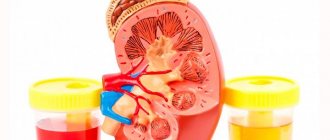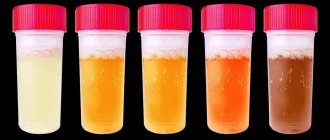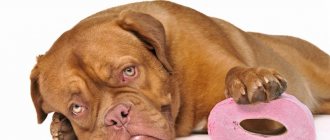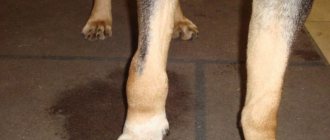The gastrointestinal system of dogs is very delicate. She quickly reacts to low-quality or defective food, dirt in food, various toxic substances and foreign objects, which are often swallowed by dogs. Also, the functioning of the gastrointestinal tract can be affected by various infections and pathogenic bacteria, not to mention possible age-related changes and neoplasms.
As a rule, due to all these factors, the digestive system becomes upset, and the dog begins to have diarrhea interspersed with blood, or even consisting entirely of black masses. This is a serious symptom of a number of dangerous diseases. If you find blood in your dog's feces, you should immediately contact a veterinarian. In the worst case, delay will cost your pet his life.
Reasons for appearance
By the color of stool and bloody inclusions, you can understand in which part of the gastrointestinal tract the bleeding began. If you ate scarlet blood, then there is damage in the rectum, and if the color of the discharge is black, then the source is the stomach or intestines. In any case, the first priority is to determine the cause of this condition.
Bloody diarrhea can be caused by:
- Helminthiasis may well provoke such ailment. Adding to it lethargy, refusal to eat and rapid exhaustion.
- Hemorrhagic gastroenteritis , which develops due to poor nutrition or an accidentally swallowed sharp object.
- Parvovirus enteritis will bring with it not only diarrhea, but also discharge from the eyes and nose, and fever.
- Hemorrhoids are perhaps the most harmless cause of bloody spots in the stool.
- Poisoning with toxic substances . This is often a reaction to rat poison.
- Periodically, bloody traces in the feces are observed in bitches during estrus . They disappear after this period ends.
If your dog has bloody diarrhea: causes of discomfort
Stomach upset in your four-legged friend can be acute or chronic.
In the acute form, the stool becomes watery, sometimes containing mucus or blood. Acute diarrhea can last from 2 to 14 weeks, chronic - up to several months. In addition to loose stools, there are other symptoms: the animal is vomiting, it is capricious, and refuses to eat. In some cases, his temperature rises, discharge from the eyes and nose begins, the pet refuses to go out for a walk, and his behavior is apathetic.
An advanced disease leads to irreversible consequences. For adult animals over 6 years of age, diarrhea can cause complete dehydration and even death.
Possible factors of the disease:
- poor nutrition;
- mechanical injuries to the anus, for example, with hard objects.
- viral, fungal, bacterial infections;
- neoplasms and inflammation of the gastrointestinal tract;
- presence of parasites;
- rabies.
If there is diarrhea with blood, veterinarians suspect diseases of the dogs’ internal organs and conduct comprehensive examinations. Diagnosis includes general blood, urine, stool tests, ultrasound and x-rays of the gastrointestinal tract. Only after collecting anamnesis do veterinarians make a diagnosis and choose the appropriate treatment tactics.
Symptoms
Bloody diarrhea scares the owner for good reason; it is often an indicator of a serious infection or contamination with a pathogenic bacterium. If, along with problems with stool, the dog develops the following symptoms, then it should be urgently taken to the veterinarian:
- Diarrhea lasts more than two days.
- Feces give off a strong, unpleasant odor.
- Appetite is greatly reduced.
- Vomiting and nausea appear.
- Temperature rises by several degrees.
- Refusal of water.
- The mucous membranes change color or become sharply pale.
- Behavior changes, unusual reactions to external stimuli appear.
Even without the above symptoms, blood in the stool is a bad sign. If you notice it, contact your veterinarian.
Treatment options
When contacting a clinic with similar symptoms, treatment is prescribed only after a thorough diagnosis, since it is necessary not only to stop the ailment, but also to identify and eliminate the root cause. The first advice the veterinarian gives is to fast for at least 12 hours. And then the examination and treatment begins within the walls of the clinic.
It is worth remembering that you cannot delay when such strong signs of illness appear. Delay often leads to complications, such as paralysis of the paws or severe exhaustion.
Depending on the identified disease, the following treatment methods are used:
- Painkillers are prescribed to relieve discomfort.
- In case of intoxication, it is necessary to cleanse the body using absorbent agents.
- Water-salt and nutrient drips will help keep your pet in good condition.
- In difficult cases, surgery is required.
- The root cause is treated with a suitable set of medications.
Treatment of bloody diarrhea in dogs
Complex treatment can only be prescribed by an experienced veterinarian, who will not have any difficulty analyzing the situation and identifying the root cause of blood inclusions in the pet’s stool.
It is much easier in cases where bleeding is caused by the use of medications, to which the animal’s body responds with a peculiar reaction. Usually, after their abolition and the prescription of hemostatic drugs, the stool completely normalizes.
It is more difficult with diarrhea that is debilitating to the dog, caused by an infection or parasite in the gastrointestinal tract. Here you cannot do without drip procedures, which are carried out in stationary conditions, which will help restore the water balance in the animal’s body. Along the way, antibiotics with hemostatic agents, gastroprotectors, astringents and strict adherence to diet are prescribed.
Surgical intervention is used in the event of foreign bodies entering and neoplasms being detected, where chemotherapy and radiation therapy can be prescribed along the way.
A timely visit to a veterinarian is the only correct decision if blood and mucus are detected in your pet’s stool, which will further help promote a speedy recovery.
Diet features
Regardless of the specific cause of the disease, during the period of treatment and recovery the animal must be in quarantine and adhere to a specially fairly strict diet that will allow the damaged intestinal mucosa to recover. The attending veterinarian will inform you about the rules of nutrition and a suitable diet before leaving for home quarantine.
However, there are general rules that are mandatory for everyone:
- During the period of diarrhea or vomiting with blood, the dog should not be given food . The period of hunger can last from 12 hours to a day. If the condition does not stabilize during this time, the necessary nutrients will be given intravenously.
- Before entering the clinic, it is very important not to allow dehydration to develop. Therefore, water is required. If the dog refuses to drink, it is poured into the mouth using a syringe, but in small doses.
- After the diarrhea stops and he is allowed to start eating on his own, the dog does not receive his usual food, but well-cooked rice. You can cook it with chicken or beef broth.
- Portions should be small and meals should be frequent (4-5 times a day). Gradually, portions will increase and feeding frequency will decrease.
- After some time, it is necessary to include fermented milk products in small quantities in the menu in order to restore the microflora of the stomach.
- The transition to a normal diet depends on the root cause of the onset of problems. It can take from several days to a couple of weeks.
In especially severe cases with many complications, the animal never returns to normal food, eating a special diet for the rest of its days.
First aid
What should you do if your dog has bloody diarrhea and vomiting? If the animal’s condition is satisfactory and there are no complications such as lethargy, high fever, very frequent bowel movements and vomiting, it is necessary to arrange a fasting day for the pet . Lasts 24 hours. The dog should be provided with clean drinking water and given water frequently, but in small portions. In case of poisoning, activated carbon and Smecta are recommended to cleanse the body. In traditional medicine, you can give a decoction of oak bark, which improves the functioning of the digestive system.
To relieve pain and relieve spasms, you can give No-shpa or other painkillers.
If the symptoms recur very often and any complications arise, diarrhea and vomiting do not stop within one or two days, you should immediately go to a veterinary clinic for an accurate diagnosis and further treatment. Because dehydration may occur and the animal may die.
All necessary tests should be taken at the veterinary clinic. The veterinarian must use medications or droppers, depending on the dog’s condition, to relieve spasms and relieve pain, remove all toxic substances, improve blood clotting and, without fail, restore the water balance in the body. Then, depending on the identified cause, prescribe appropriate treatment to eliminate the disease.
If this is necessary, the dog should stay for several days in the clinic under the supervision of a doctor. During the recovery period, the animal needs rest:
- Any emotional or physical stress is strictly prohibited
- Follow a special low-calorie diet, which includes minimal consumption of fat, salt and spices in your pet's food.
Prevention
It is quite possible to protect your pet from intestinal damage and bloody diarrhea. You just need to follow a small set of safety rules:
- Do not feed your dog raw meat of unknown origin . Boil or steam it. As a last resort, use meat that has been industrially frozen.
- Do not feed your animal food of unknown origin and age. Food, even from a good manufacturer, will spoil over time. Keep an eye on expiration dates.
- Monitor the animal's condition and mood . This way you can notice the first signs of an approaching disease.
- Don't let your dog pick up anything on the street . Even if what you pick up looks edible, no one can guarantee that it is not the bait of dog hunters.
- Do not use small or sharp objects for joint games . If your pet is curious, then move them away as far as possible.
- Do not feed your pet only dry food . It must be alternated with wet, otherwise it can lead to big problems with the stomach and intestines.
- Get a preventive examination from a veterinarian once every six months . This will allow you to find out in time about any changes in the dog’s condition.
Causes
Bloody diarrhea in a dog can be a symptom of:
- Parvovirus enteritis. Most affected puppies die between the ages of 2 and 18 months. The stool is initially mucous, then watery, and finally becomes bloody with a foul odor. The dog is vomiting foam.
- Leptospirosis. Bloody diarrhea indicates the severity of the disease. The animal quickly dies.
- Chemical poisoning. The dog can pick them up on the street.
- Traumatic enterocolitis. The cause may be sharp edges of swallowed bones or sticks, or other inedible objects.
- Chumki. Along with diarrhea, the dog may experience mucous discharge from the nose and eyes, photophobia, lethargy, and weakness. The temperature rises above 40 degrees.
- Long-term use of non-steroidal anti-inflammatory drugs for humans and glucocorticoids.
- Helminthiasis, dysbacteriosis. Worms (nematodes, liver flukes) damage the intestinal mucosa, which is penetrated by a network of blood vessels. As a result, they begin to bleed. With dysbiosis, the intestinal walls are damaged by small particles of food.
- Intestinal infections in puppies due to severe stress and immunodeficiency.
- An atypical form of rabies with a severe form of gastroenteritis.
- Tumors. Growing into the intestinal walls, they damage the mucous membrane, blood vessels, and tissues, causing bleeding. May lead to purulent peritonitis. Neoplasms are more often observed in adult animals.











